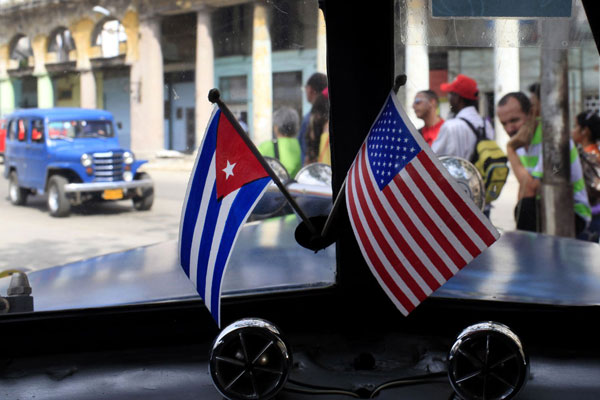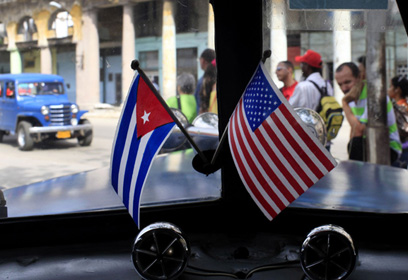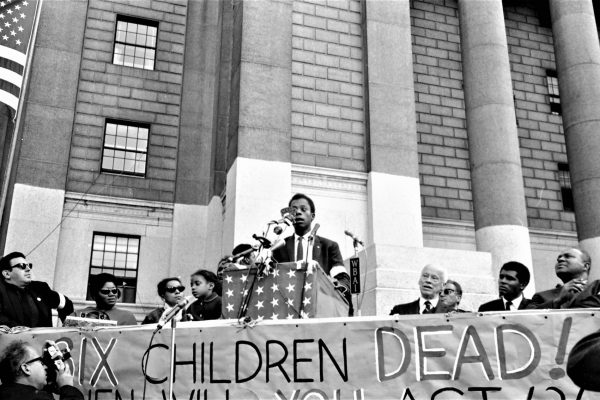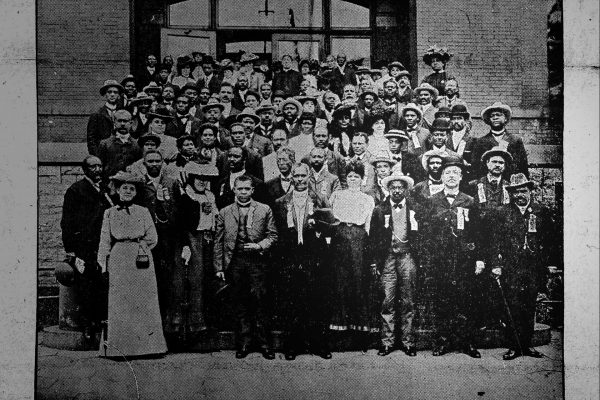
Photograph: Day Donaldson
In December 2014 President Obama made the stunning announcement that he had used his executive power to negotiate with Cuba and would reestablish diplomatic relations with our erstwhile enemy. Throughout the subsequent year, the U.S. media focused on the more exciting aspects of reestablishing diplomatic ties: the long-overdue removal of Cuba from the list of state sponsors of terrorism; the moving act of raising the flag above the reinstated U.S. embassy in Havana; and most recently, the sudden announcement of big business interests sitting down with U.S. and Cuban officials to negotiate compensation for properties expropriated by the revolution a half-century ago. Our official recognition of the Cuban government after fifty-five years of isolation, open aggression, and clandestine destabilization is extremely important and must continue.
Yet what already seems clear is that the renewal of U.S. relations will not automatically bring widespread prosperity, much less social equality, to Cuba. The December 17, 2014 rapprochement between Cuba and the United States came on the heels of several years of Cuban internal reform that have deepened inequality, stacking the deck of the new political landscape in favor of some Cubans. Not surprisingly, race and gender figure prominently in Cuba’s growing disparities.
Even the most measurable change so far this year—the spike in American visitors—may contribute to the island’s deepening inequality. The growing flood of U.S. tourists will inevitably provide new clientele for the restaurants, home-stays, and other urban services that are the bread and butter of Havana’s new upwardly mobile class of business owners, who tend to be light-skinned and often male, threatening to leave Afro-Cubans, women, and vulnerable groups, such as the elderly, behind.
• • •
Why has inequality gradually returned despite the revolutionary government’s stated dedication to creating an egalitarian society? The problem has deep roots. Far from being an island frozen in time, Cuban society has changed rapidly over the past fifty years.
The revolution asserted that it had ended discrimination based on race or sex. Thereafter it was taboo to suggest otherwise.
In the heady revolutionary year of 1959, expectations ran high. Although Havana was known as the “Paris of the Caribbean,” much of the island was impoverished, a legacy of its history as a sugar colony where fortunes were raised on plantations fueled by African slave labor. With the revolution in power, historically oppressed Afro-Cubans and their allies pushed for redress, as historians Alejandro de la Fuente and Devyn Spence Benson have shown. An unprecedented national debate on race and racism followed in the mass media, at conferences and roundtables, and among new pro-revolutionary anti-racist organizations. Similarly, throughout 1959 women activists—including many affiliated with the Communist Party—formed new revolutionary women’s groups, sponsored conferences to discuss women’s rights, and presented their demands to the revolutionary leadership. It was exciting, effervescent, a time when it still seemed that the revolution might accomplish anything.
But by mid-1960, fearful of any social cleavages that might be exploited by growing internal opposition or the United States, the revolutionary government began to demand “unity.” In its drive to centralize political power, it shuttered independent organizations, even those that did not oppose the revolution. In mid-1960, all autonomous women’s groups were collapsed into the Federation of Cuban Women, a top-down mass organization that served mostly to transmit directives to women and mobilize them for the revolutionary cause. Autonomous Afro-Cuban associations of various kinds were dismantled by the mid 1960s. (Unlike the women’s groups, they were never replaced by a government-sanctioned Afro-Cuban mass organization.) These closures effectively removed formal organizational channels for dissenting or merely independent opinions on race and gender equity. Afro-Cuban religions, too, were pushed underground, where they survived and reemerged to flourish in the 1990s.
By 1962, the revolutionary government confidently asserted that it had eradicated all discrimination based on race or sex. Thereafter it became a political taboo—in fact, virtually counterrevolutionary—to suggest otherwise. It is true that the social programs undertaken by the government during the first few years of the revolution benefitted Afro-Cubans and women disproportionately, especially the expansions of healthcare, education, and professional opportunities. Yet certain underlying ideas and social practices were left intact. The more robust, widespread questioning of race and gender inequalities and ideologies that might have been spurred by Afro-Cuban and women activists in 1959 was a lost opportunity. These fault lines would reemerge in the 1990s.
• • •
In 1961, as U.S.-Cuban relations definitively ruptured, Cuba drifted into the Soviet orbit. The alliance with the USSR buoyed the Cuban economy for a time. But the relative abundance of the Soviet years, especially the 1980s, was supported by massive subsidies. The fall of the Soviet Union prompted an epic depression in Cuba in the 1990s, known as the Special Period, a traumatic decade that scarred the population and prompted thousands to attempt the dangerous passage to U.S. shores on rickety homemade rafts. The redistributive efforts of the Cuban state—roughly equal salaries, rationed foods, universal access to healthcare and education, and free or highly subsidized services—were eroded or rendered insignificant by the economic shock of the 1990s, never to recover.
Alejandro de la Fuente was among the first to document the return of racial inequality during the Special Period. The social schisms wallpapered over in the 1960s now returned with a vengeance in the 1990s. In the early 1960s much of the island’s middle and upper class, which were overwhelmingly white, decamped for Miami. There they established a powerful exile community, still largely white if now less affluent. In the 1990s they sent remittances—a crucial lifeline—to their family members on their island, who were also mostly light-skinned. The historic patterns of race and residence that the urban reforms had failed to disrupt were now monetized, as predominantly white neighborhoods converted their better housing stock into lucrative rentals. White, formerly middle-class Cubans mobilized the cultural capital still embedded in their social networks to jostle for jobs and scarce goods. Afro-Cubans were elbowed out of increasingly competitive positions in the tourist industry, one of the only ways to access hard currency (as opposed to Cuban pesos or convertible pesos, which have no convertible value). Racist ideologies, prohibited in public since the 1960s but maintained in private, now reemerged.
At the same time, the historic limitations of revolutionary measures to liberate women also came back to haunt Cuba. The revolutionary government had emphasized women’s entry into the public sphere yet did little to proactively remold the practices of the domestic sphere. Although the Family Code of 1975 stipulated that women and men should share domestic burdens equally, women continued to undertake the vast majority of domestic labor. Women’s double shift was taxing enough before the 1990s but, as the Spanish anthropologist Isabel Holgado Fernández documented, the hardships of the Special Period were particularly punishing for women. The shortages of necessary goods elongated reproductive labor excruciatingly. Cooking, Childcare, Standing in Line: this was the new “socialist triad” for women.
• • •
When I first began traveling to Cuba in the early 2000s, it felt like a society slowly recovering from a war or some other collective shock. The country was stabilizing, partly due to economic support from the government of Hugo Chávez in Venezuela. Cars and buses returned to the streets; market and store shelves were replenished. But survival stories were still fresh on people’s minds. My friends recounted how their families had made it through the darkest days of the Special Period. They told harrowing stories of the relatives and friends who had fled on rafts or even run over the land-mined border to the military base in Guantánamo. They shared memories of entire families sleeping camped along the water to weather the unbearable heat during long summer blackouts. Although life was improving for most Cubans, economic liberalization also slowed down, and many of the private restaurants and family-run bed-and-breakfasts lost their licenses and closed shop.
When Fidel Castro stepped down in 2007 following an illness, Raúl Castro began to slowly implement social and economic reforms. For a weary populace, many of these were welcome: the removal of restrictions on travel abroad; an open market in houses and cars; less emphasis on political mobilization and more on increasing efficiency and production.
We may be witnessing the feminization of unemployment in Cuba.
The most recent round of reforms announced in 2011, know as the Lineamientos (Guidelines), marked a major economic restructuring: the state would gradually and permanently shed up to 40 percent of its workers. The private sector, once seen as something of a necessary evil, was now encouraged. The government released a number of newly approved private professions for which Cubans may solicit small business licenses. These recent reforms are consolidating the social inequalities that began to grow during the Special Period.
For reasons that were already becoming apparent in the 1990s, Afro-Cubans are far less able to take advantage of the current round of economic reforms. They more frequently lack family abroad to send remittances that could be used to either offset their low salaries in the state sector or to start a small business in the private sector. As anthropologist Katrin Hansing has recently argued:
Most successful, private businesses, whether paladares [family-run restaurants], bed and breakfasts, beauty parlors, nightclubs, yoga studios and gyms etc., are owned . . . by white Cubans. Homes in exclusive, overwhelmingly white, neighborhoods, such as El Vedado, Miramar and Siboney, are being bought and sold for exorbitantly high prices and being restored to their former glory with capital from abroad, furthering the association between wealth and whiteness.
Recent studies by Cuban sociologists such as Dayma Echeverría, Teresa Lara, and Ileana Díaz suggest that the current restructuring may also disproportionately affect women. Women tend to be overrepresented in the ongoing layoffs from state-owned businesses because they are clustered in services rather than in the strategic sectors of mining, agriculture, manufacture, or pharmaceuticals. Even when women are not laid off but instead reassigned internally within state entities, some sociologists speculate that women may be getting shuffled downward toward positions of lower pay and responsibility. In general, women—especially younger and less educated ones—are being left out of the formal workforce at greater rates than men, producing a pool of women the Cuban government dubs inactivas: neither employed nor seeking work, and not enrolled in school.
Once unemployed, women have a harder time than their male counterparts finding new jobs either in the state sector or the growing private sector. There are a number of reasons for this. Existing state-run job placement programs target certain groups that tend to be male, such as people finishing military service (which is mandatory only for men) or those recently freed from prison (mostly men).
In the private sector, men tend to be the licensed owners of the assets that form the foundation for most small businesses: agricultural plots, trucks, cars, and other goods. (An important exception to this rule is the large number of mostly white women proprietors who run small bed-and-breakfasts.) Men moreover may have easier access than women to private sources of credit and to the black market networks often essential to running a business in today’s Cuba. In addition, most of the state-approved occupations for small businesses are traditionally seen as masculine, such as taxi driver, farmer, or construction worker. Finally, many of the newly approved small business categories involve manual or artisanal labor, making them less attractive to professionals. The revolution’s much-lauded accomplishments in raising women’s rates of education—women are now 60 percent or more of college graduates—may have perversely left them ill-equipped for the niche markets of the new Cuba.
These discrepancies are reflected in statistics on the growing private sector. As of August 2011, less than a quarter of small business (cuentapropista) licenses were in the hands of women. Women are most likely to enter the private sector as employees, not business owners. Clearly, many women are also working in the private sector without licenses, probably mostly in food preparation, childcare, and as domestics. While this shelters them from the burden of paying taxes, it also prevents them from taking advantage of social security, which was updated recently to cover private sector employees. We may thus be witnessing a gradual “feminization” of unemployment, underemployment, and informal employment in Cuba.
The 2011 economic reforms have helped consolidate the emergence of a more dynamic and higher-paid private sector, largely male and light-skinned, part of a new elite that is best positioned to take advantage of the economic changes looming on the horizon. Recognizable patterns of poverty are also consolidating, marked by decrepit housing in far-flung neighborhoods with poor infrastructure, subsistence-level caloric intake, and lack of contacts to find job opportunities. Afro-Cubans are vastly overrepresented among the new poor, and single mothers and the elderly are especially vulnerable within this group.
As the United States and Cuba further their rapprochement, there is a danger that the future influx of investment capital, foreign companies, and American tourists will further these patterns rather than disrupt them. Ironically, the revolution’s long-overdue recognition by its northern neighbor may also hasten the demise of its fundamental project of social equality. December 17 may mark a Pyrrhic victory after all.
• • •
It is unclear what the next few years will bring. Between the electoral defeat of the Venezuelan left in December and the U.S. presidential elections slated for next fall, new developments may come haltingly.
When I visited the island in October, my first visit after almost four years, most of my Cuban friends flatly declared that nothing had changed since I had last seen them. Yet I could sense subtle differences percolating in their lives, especially in the various entrepreneurial schemes they had in mind. One friend contemplated opening a small juice stand in front of her house to take advantage of the morning commuters walking by. It would be a Cuban peso business, not a high-earning one, but something to complement her pension during her coming retirement. Another hoped to take advantage of the more relaxed travel regulations for a quick “fundraising” trip to Ecuador, in which he planned to bring back a light motorbike and some cell phones to resell at a large markup. (The Ecuadorian government’s recent decision to reinstate visa requirements for Cubans will likely have dashed his plans.)
On my last night in Havana a friend took me on a long walk past the dark and desolate piers where large cruise ships hailing directly from U.S. ports will soon dock. Beyond that, he gestured, was the port of Mariel, once best known for the mass exodus of 1980, and where an economic “free zone” is now in development. I was reminded of my very first visit to the island in 2000, when a woman I met recalled with a sudden burst of nostalgia the Soviet cargo ships you could see docking daily before the collapse of the Soviet Union left Cuban ports quiet. Havana’s sheltered bay—the raison d’etre for the city’s original settlement—will gradually be repurposed for mass tourism, waterfront condos, and high-end restaurants.
There are some Cubans who view the current moment as one of opportunity as well as risk. In November I attended a talk given by Afro-Cuban cultural critic Roberto Zurbano, who was visiting Rutgers University in Newark. He discussed various ways to inject conversations about race and Afro-Cuban empowerment into the current bilateral thaw. He was enthusiastic about future exchanges between civil society groups and institutions of higher education. He saw such exchanges as an opportunity for Cuba’s anti-racist struggle to find more transnational allies.
Later I asked him what, if any, changes he had noticed since “D-17.” He cautioned that it was too early to tell; most change so far has been at the level of discourse. But he mentioned one unexpectedly positive effect of U.S. tourism, explaining that the uptick in African American travelers had already changed the dynamics of street-level policing. Havana cops were easing off their notorious harassment of black youths out of fear they might be North American tourists. “It’s a small detail, but for us it’s important. Because the authorities’ perceptions of blackness will keep changing as African American tourism grows.” It is an example of the kind of unanticipated effects that the coming years may bring.








